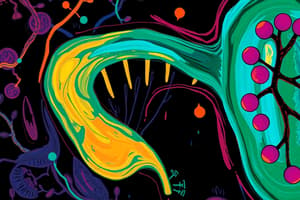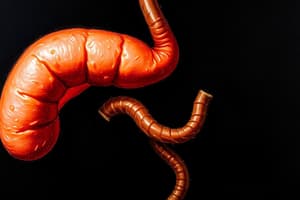Podcast
Questions and Answers
What role do auto antigens and T-helper cells play in the development of Type 1 diabetes?
What role do auto antigens and T-helper cells play in the development of Type 1 diabetes?
Auto antigens trigger T-helper cell activation, leading to the autoimmune attack on insulin-producing β-cells.
How does the pathophysiology of Type 2 diabetes differ from that of Type 1 diabetes?
How does the pathophysiology of Type 2 diabetes differ from that of Type 1 diabetes?
Type 2 diabetes is characterized by insulin resistance and later onset, while Type 1 is driven by autoimmune destruction of β-cells.
Describe the function of GLUT transporters in glucose metabolism in diabetes.
Describe the function of GLUT transporters in glucose metabolism in diabetes.
GLUT transporters facilitate the uptake of glucose into cells, which is impaired in diabetes, leading to elevated blood glucose levels.
What impact can gestational diabetes have on both the mother and the child?
What impact can gestational diabetes have on both the mother and the child?
What are the primary management strategies for diabetic emergencies like hypoglycemia and DKA?
What are the primary management strategies for diabetic emergencies like hypoglycemia and DKA?
What is the primary mechanism leading to the destruction of β-cells in Type 1 Diabetes Mellitus (DM)?
What is the primary mechanism leading to the destruction of β-cells in Type 1 Diabetes Mellitus (DM)?
How does insulin resistance in Type 2 DM affect glucose uptake in cells?
How does insulin resistance in Type 2 DM affect glucose uptake in cells?
What is the role of GLUT-4 in glucose metabolism?
What is the role of GLUT-4 in glucose metabolism?
What are the two main risks associated with gestational diabetes for the newborn?
What are the two main risks associated with gestational diabetes for the newborn?
What hormonal changes are believed to contribute to insulin resistance during pregnancy?
What hormonal changes are believed to contribute to insulin resistance during pregnancy?
What is a common therapeutic approach for managing diabetic emergencies?
What is a common therapeutic approach for managing diabetic emergencies?
In what way can metabolic syndrome influence the pathophysiology of Type 2 DM?
In what way can metabolic syndrome influence the pathophysiology of Type 2 DM?
How does GLUT-2 function in the body’s glucose regulation?
How does GLUT-2 function in the body’s glucose regulation?
What is the primary pathophysiological mechanism behind Type 1 Diabetes Mellitus?
What is the primary pathophysiological mechanism behind Type 1 Diabetes Mellitus?
How does insulin resistance in Type 2 Diabetes differ from insulin deficiency in Type 1 Diabetes?
How does insulin resistance in Type 2 Diabetes differ from insulin deficiency in Type 1 Diabetes?
What is the role of GLUT transporters in glucose metabolism, particularly in the context of insulin secretion?
What is the role of GLUT transporters in glucose metabolism, particularly in the context of insulin secretion?
What are the potential impacts of Gestational Diabetes on a mother and her child?
What are the potential impacts of Gestational Diabetes on a mother and her child?
What is a common diabetic emergency and how should it be managed?
What is a common diabetic emergency and how should it be managed?
Describe the physiological process that triggers insulin release when blood glucose levels exceed 3.9 mmol/L.
Describe the physiological process that triggers insulin release when blood glucose levels exceed 3.9 mmol/L.
How does hyperglycemia relate to the complications faced by patients with uncontrolled diabetes?
How does hyperglycemia relate to the complications faced by patients with uncontrolled diabetes?
What role do incretins like GLP-1 and GIP play in glucose metabolism?
What role do incretins like GLP-1 and GIP play in glucose metabolism?
Study Notes
Pancreas Functions
- The pancreas serves as both a digestive and endocrine gland.
- Digestive function: secretes pancreatic juice aiding in digestion.
- Endocrine function: Islets of Langerhans within the pancreas contain:
- Alpha cells: Secrete glucagon, elevating blood glucose.
- Beta cells: Secrete insulin, decreasing blood glucose.
- Delta cells: Secrete somatostatin, inhibiting glucagon and insulin release.
Diabetes Overview
- Type 1 diabetes: Occurs due to an autoimmune attack on beta cells, leading to insulin deficiency.
- Type 2 diabetes: Characterized by insulin resistance or inadequate response, often associated with obesity and increasing in children.
- Gestational diabetes: Develops during pregnancy, usually resolving after delivery, but increasing risk for complications.
Regulation of Blood Glucose
- Insulin: Facilitates glucose uptake, converts it into glycogen, inhibiting gluconeogenesis.
- Glucagon: Opposes insulin by stimulating glycogen breakdown and gluconeogenesis.
- Other hormones including adrenaline, cortisol, and growth hormone increase blood glucose levels.
Insulin Synthesis and Release
- Pro-insulin is cleaved into insulin and C-peptide (useful to measure insulin production).
- Glucose levels above 3.9 mmol/L trigger insulin secretion through a chain of cellular events:
- K+ channels are inhibited.
- Ca2+ influx occurs.
- Incretins (GLP-1, GIP): Released from the gut, they stimulate insulin release and suppress glucagon after meals.
Insulin Mechanism of Action
- Insulin binds to its receptor, triggering autophosphorylation.
- This activates IRS-1, initiating a cascade that activates enzymes like protein kinase B and MAP kinase.
- This cascade causes GLUT4 (a glucose transporter) to move to the cell membrane, allowing glucose uptake.
- Insulin also facilitates the uptake of amino acids, potassium, magnesium, and phosphate into cells.
GLUT Types
- GLUT-4: Insulin-dependent glucose transporter in skeletal muscle and adipose tissue.
- GLUT-2: Primary glucose transporter for beta cells and liver cells, functioning when plasma glucose levels are high.
- GLUT-1: Found in all tissues, essential for glucose transport in nervous system cells.
Gestational Diabetes
- Affects approximately 6% of pregnancies.
- Risk factors: Obesity, significant weight gain during pregnancy, family history of diabetes.
- Incidence decreasing by ~4% annually, likely due to improved maternal healthcare.
- Thought to be linked to hormonal changes during pregnancy creating insulin resistance.
- Risks for the baby:
- Macrosomia (large baby) or microsomia (small baby)
- Neonatal hypoglycemia
- Electrolyte disorders
- Respiratory distress syndrome
- Diabetic effect usually resolves after delivery.
Pathophysiology
- Type 1 DM: T-cell mediated destruction of beta cells influenced by genetic predisposition (e.g., HLA genes) and environmental triggers (e.g., viral infections).
- Type 2 DM: Involves insulin resistance, often associated with obesity and metabolic syndrome.
Clinical Features
- Type 1: Early onset, rapid symptom progression, insulin-dependent, often lean body type.
- Type 2: Later onset, slower progression, often linked to obesity, managed with diet, oral agents, or insulin.
- Symptoms of both:
- Polyuria (frequent urination)
- Polydipsia (thirst)
- Polyphagia (hunger)
Diagnosis
- Fasting plasma glucose ≥7.0 mmol/L or random plasma glucose ≥11.1 mmol/L confirms diabetes.
- HbA1c provides a measure of long-term glucose control.
Diabetic Emergencies
- Hypoglycemia: Occurs when blood glucose drops below 3.5 mmol/L. Symptoms: sweating, tremors, confusion, and coma. Treatment: Fast-absorbing carbohydrates or IV glucose/glucagon.
- Diabetic Ketoacidosis (DKA): Common in Type 1, marked by hyperglycemia, ketosis, and metabolic acidosis.
- Hyperosmolar Non-Ketotic Hyperglycemia (HNKH): Seen in Type 2, characterized by severe dehydration and high blood glucose without ketones.
Complications
- Microvascular: Retinopathy, nephropathy, neuropathy.
- Macrovascular: Increased risk of heart attack, stroke, and peripheral artery disease.
Studying That Suits You
Use AI to generate personalized quizzes and flashcards to suit your learning preferences.
Related Documents
Description
This quiz explores the dual roles of the pancreas as both a digestive and endocrine gland. You'll learn about the different types of diabetes, their causes, and the pancreas's function in regulating blood glucose levels. Test your knowledge on how insulin and glucagon interact in the body.




